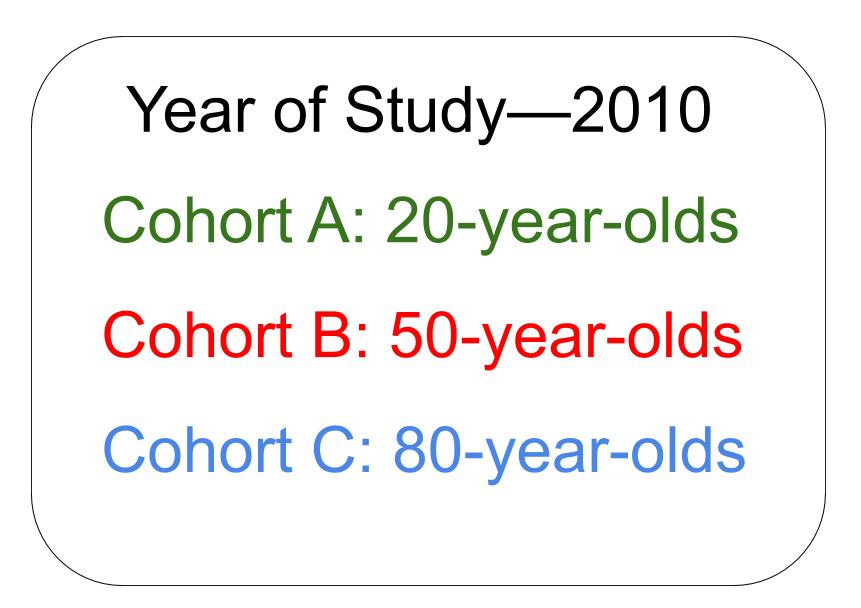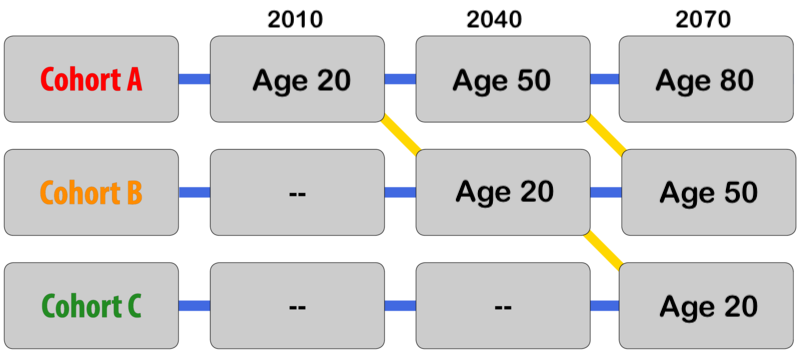Learning Outcomes
- Compare advantages and disadvantages of developmental research designs (cross-sectional, longitudinal, and sequential)
Now you know about some tools used to conduct research about human development. Remember, research methods are tools that are used to collect information. But it is easy to confuse research methods and research design. Research design is the strategy or blueprint for deciding how to collect and analyze information. Research design dictates which methods are used and how. Developmental research designs are techniques used particularly in lifespan development research. When we are trying to describe development and change, the research designs become especially important because we are interested in what changes and what stays the same with age. These techniques try to examine how age, cohort, gender, and social class impact development.
Cross-sectional designs
The majority of developmental studies use cross-sectional designs because they are less time-consuming and less expensive than other developmental designs. Cross-sectional research designs are used to examine behavior in participants of different ages who are tested at the same point in time. Let’s suppose that researchers are interested in the relationship between intelligence and aging. They might have a hypothesis (an educated guess, based on theory or observations) that intelligence declines as people get older. The researchers might choose to give a certain intelligence test to individuals who are 20 years old, individuals who are 50 years old, and individuals who are 80 years old at the same time and compare the data from each age group. This research is cross-sectional in design because the researchers plan to examine the intelligence scores of individuals of different ages within the same study at the same time; they are taking a “cross-section” of people at one point in time. Let’s say that the comparisons find that the 80-year-old adults score lower on the intelligence test than the 50-year-old adults, and the 50-year-old adults score lower on the intelligence test than the 20-year-old adults. Based on these data, the researchers might conclude that individuals become less intelligent as they get older. Would that be a valid (accurate) interpretation of the results?

Figure 1. Example of cross-sectional research design
No, that would not be a valid conclusion because the researchers did not follow individuals as they aged from 20 to 50 to 80 years old. One of the primary limitations of cross-sectional research is that the results yield information about age differences not necessarily changes with age or over time. That is, although the study described above can show that in 2010, the 80-year-olds scored lower on the intelligence test than the 50-year-olds, and the 50-year-olds scored lower on the intelligence test than the 20-year-olds, the data used to come up with this conclusion were collected from different individuals (or groups of individuals). It could be, for instance, that when these 20-year-olds get older (50 and eventually 80), they will still score just as high on the intelligence test as they did at age 20. In a similar way, maybe the 80-year-olds would have scored relatively low on the intelligence test even at ages 50 and 20; the researchers don’t know for certain because they did not follow the same individuals as they got older.
It is also possible that the differences found between the age groups are not due to age, per se, but due to cohort effects. The 80-year-olds in this 2010 research grew up during a particular time and experienced certain events as a group. They were born in 1930 and are part of the Traditional or Silent Generation. The 50-year-olds were born in 1960 and are members of the Baby Boomer cohort. The 20-year-olds were born in 1990 and are part of the Millennial or Gen Y Generation. What kinds of things did each of these cohorts experience that the others did not experience or at least not in the same ways?
You may have come up with many differences between these cohorts’ experiences, such as living through certain wars, political and social movements, economic conditions, advances in technology, changes in health and nutrition standards, etc. There may be particular cohort differences that could especially influence their performance on intelligence tests, such as education level and use of computers. That is, many of those born in 1930 probably did not complete high school; those born in 1960 may have high school degrees, on average, but the majority did not attain college degrees; the young adults are probably current college students. And this is not even considering additional factors such as gender, race, or socioeconomic status. The young adults are used to taking tests on computers, but the members of the other two cohorts did not grow up with computers and may not be as comfortable if the intelligence test is administered on computers. These factors could have been a factor in the research results.
Another disadvantage of cross-sectional research is that it is limited to one time of measurement. Data are collected at one point in time and it’s possible that something could have happened in that year in history that affected all of the participants, although possibly each cohort may have been affected differently. Just think about the mindsets of participants in research that was conducted in the United States right after the terrorist attacks on September 11, 2001.
Longitudinal research designs

Figure 2. Longitudinal research studies the same person or group of people over an extended period of time.
Longitudinal research involves beginning with a group of people who may be of the same age and background (cohort) and measuring them repeatedly over a long period of time. One of the benefits of this type of research is that people can be followed through time and be compared with themselves when they were younger; therefore changes with age over time are measured. What would be the advantages and disadvantages of longitudinal research? Problems with this type of research include being expensive, taking a long time, and participants dropping out over time. Think about the film, 63 Up, part of the Up Series mentioned earlier, which is an example of following individuals over time. In the videos, filmed every seven years, you see how people change physically, emotionally, and socially through time; and some remain the same in certain ways, too. But many of the participants really disliked being part of the project and repeatedly threatened to quit; one disappeared for several years; another died before her 63rd year. Would you want to be interviewed every seven years? Would you want to have it made public for all to watch?
Longitudinal research designs are used to examine behavior in the same individuals over time. For instance, with our example of studying intelligence and aging, a researcher might conduct a longitudinal study to examine whether 20-year-olds become less intelligent with age over time. To this end, a researcher might give an intelligence test to individuals when they are 20 years old, again when they are 50 years old, and then again when they are 80 years old. This study is longitudinal in nature because the researcher plans to study the same individuals as they age. Based on these data, the pattern of intelligence and age might look different than from the cross-sectional research; it might be found that participants’ intelligence scores are higher at age 50 than at age 20 and then remain stable or decline a little by age 80. How can that be when cross-sectional research revealed declines in intelligence with age?

Figure 3. Example of a longitudinal research design
Since longitudinal research happens over a period of time (which could be short term, as in months, but is often longer, as in years), there is a risk of attrition. Attrition occurs when participants fail to complete all portions of a study. Participants may move, change their phone numbers, die, or simply become disinterested in participating over time. Researchers should account for the possibility of attrition by enrolling a larger sample into their study initially, as some participants will likely drop out over time. There is also something known as selective attrition—this means that certain groups of individuals may tend to drop out. It is often the least healthy, least educated, and lower socioeconomic participants who tend to drop out over time. That means that the remaining participants may no longer be representative of the whole population, as they are, in general, healthier, better educated, and have more money. This could be a factor in why our hypothetical research found a more optimistic picture of intelligence and aging as the years went by. What can researchers do about selective attrition? At each time of testing, they could randomly recruit more participants from the same cohort as the original members, to replace those who have dropped out.
The results from longitudinal studies may also be impacted by repeated assessments. Consider how well you would do on a math test if you were given the exact same exam every day for a week. Your performance would likely improve over time, not necessarily because you developed better math abilities, but because you were continuously practicing the same math problems. This phenomenon is known as a practice effect. Practice effects occur when participants become better at a task over time because they have done it again and again (not due to natural psychological development). So our participants may have become familiar with the intelligence test each time (and with the computerized testing administration).
Another limitation of longitudinal research is that the data are limited to only one cohort. As an example, think about how comfortable the participants in the 2010 cohort of 20-year-olds are with computers. Since only one cohort is being studied, there is no way to know if findings would be different from other cohorts. In addition, changes that are found as individuals age over time could be due to age or to time of measurement effects. That is, the participants are tested at different periods in history, so the variables of age and time of measurement could be confounded (mixed up). For example, what if there is a major shift in workplace training and education between 2020 and 2040 and many of the participants experience a lot more formal education in adulthood, which positively impacts their intelligence scores in 2040? Researchers wouldn’t know if the intelligence scores increased due to growing older or due to a more educated workforce over time between measurements.
Sequential research designs
Sequential research designs include elements of both longitudinal and cross-sectional research designs. Similar to longitudinal designs, sequential research features participants who are followed over time; similar to cross-sectional designs, sequential research includes participants of different ages. This research design is also distinct from those that have been discussed previously in that individuals of different ages are enrolled into a study at various points in time to examine age-related changes, development within the same individuals as they age, and to account for the possibility of cohort and/or time of measurement effects. In 1965, K. Warner Schaie[1] (a leading theorist and researcher on intelligence and aging), described particular sequential designs: cross-sequential, cohort sequential, and time-sequential. The differences between them depended on which variables were focused on for analyses of the data (data could be viewed in terms of multiple cross-sectional designs or multiple longitudinal designs or multiple cohort designs). Ideally, by comparing results from the different types of analyses, the effects of age, cohort, and time in history could be separated out.
Consider, once again, our example of intelligence and aging. In a study with a sequential design, a researcher might recruit three separate groups of participants (Groups A, B, and C). Group A would be recruited when they are 20 years old in 2010 and would be tested again when they are 50 and 80 years old in 2040 and 2070, respectively (similar in design to the longitudinal study described previously). Group B would be recruited when they are 20 years old in 2040 and would be tested again when they are 50 years old in 2070. Group C would be recruited when they are 20 years old in 2070 and so on.

Figure 4. Example of sequential research design
Studies with sequential designs are powerful because they allow for both longitudinal and cross-sectional comparisons—changes and/or stability with age over time can be measured and compared with differences between age and cohort groups. This research design also allows for the examination of cohort and time of measurement effects. For example, the researcher could examine the intelligence scores of 20-year-olds in different times in history and different cohorts (follow the yellow diagonal lines in figure 3). This might be examined by researchers who are interested in sociocultural and historical changes (because we know that lifespan development is multidisciplinary). One way of looking at the usefulness of the various developmental research designs was described by Schaie and Baltes (1975)[2]: cross-sectional and longitudinal designs might reveal change patterns while sequential designs might identify developmental origins for the observed change patterns.
Since they include elements of longitudinal and cross-sectional designs, sequential research has many of the same strengths and limitations as these other approaches. For example, sequential work may require less time and effort than longitudinal research (if data are collected more frequently than over the 30-year spans in our example) but more time and effort than cross-sectional research. Although practice effects may be an issue if participants are asked to complete the same tasks or assessments over time, attrition may be less problematic than what is commonly experienced in longitudinal research since participants may not have to remain involved in the study for such a long period of time.
When considering the best research design to use in their research, scientists think about their main research question and the best way to come up with an answer. A table of advantages and disadvantages for each of the described research designs is provided here to help you as you consider what sorts of studies would be best conducted using each of these different approaches.
| Research Design | Advantages | Disadvantages |
|---|---|---|
| Cross-Sectional |
|
|
| Longitudinal |
|
|
| Sequential |
|
|
Try It
glossary
- attrition:
- occurs when participants fail to complete all portions of a study
- cross-sectional research:
- used to examine behavior in participants of different ages who are tested at the same point in time; may confound age and cohort differences
- longitudinal research:
- studying a group of people who may be of the same age and background (cohort), and measuring them repeatedly over a long period of time; may confound age and time of measurement effects
- research design:
- the strategy or blueprint for deciding how to collect and analyze information; dictates which methods are used and how
- selective attrition:
- certain groups of individuals may tend to drop out more frequently resulting in the remaining participants no longer being representative of the whole population
- sequential research design:
- combines aspects of cross-sectional and longitudinal designs, but also adding new cohorts at different times of measurement; allows for analyses to consider effects of age, cohort, time of measurement, and socio-historical change
Candela Citations
- Modification, adaptation, and original content. Authored by: Margaret Clark-Plaskie for Lumen Learning. Provided by: Lumen Learning. License: CC BY-NC-SA: Attribution-NonCommercial-ShareAlike
- Research Methods in Developmental Psychology. Authored by: Angela Lukowski and Helen Milojevich. Provided by: University of Calfornia, Irvine. Located at: https://nobaproject.com/modules/research-methods-in-developmental-psychology?r=LDcyNTg0. Project: The Noba Project. License: CC BY-NC-SA: Attribution-NonCommercial-ShareAlike
- Woman holding own photograph. Provided by: Pxhere. Located at: https://pxhere.com/en/photo/221167. License: CC0: No Rights Reserved